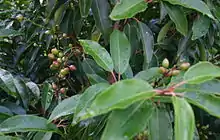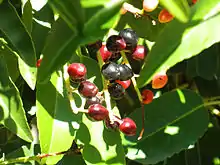Prunus lusitanica
Prunus lusitanica, the Portugal laurel,[4] is a species of flowering plant in the rose family Rosaceae, native to southwestern France, Spain, Portugal, Morocco, and Macaronesia (the Azores, Canary Islands and Madeira).[5][6]
| Prunus lusitanica | |
|---|---|
 | |
| Foliage and immature fruit | |
| Scientific classification | |
| Kingdom: | |
| (unranked): | |
| (unranked): | |
| (unranked): | |
| Order: | |
| Family: | |
| Genus: | |
| Subgenus: | |
| Section: | Laurocerasus |
| Species: | P. lusitanica |
| Binomial name | |
| Prunus lusitanica | |
| Synonyms[3] | |
|
List
| |
Description
Prunus lusitanica is an evergreen shrub or small tree growing to 3-4m tall. It will grow to 6 m (20 ft) high according to some references.[7] The bark is blackish-brown, The leaves are alternate, oval, 7–12 cm long and 3–5 cm broad, with an acute apex and a dentate margin, glossy dark green above, lighter below. They superficially resemble those of the bay laurel, which accounts for its often being mistaken for one.
The flowers are small (10–15 mm diameter) with five small white petals; they are produced on erect or spreading racemes 15–25 cm long in late spring. The fruit is a small cherry-like drupe 8–13 mm in diameter, green or reddish green at first, turning dark purple or black when ripe in late summer or early autumn.[8]
Distribution and habitat


Prunus lusitanica is rare in the wild, found mainly along mountain streams, preferring sunshine and moist but well-drained soils. It is moderately drought-tolerant. It reproduces either sexually (the most successful method) or asexually by cloning from shoots.[9]
Name
The species was first scientifically described by Linnaeus in Species Plantarum in 1753. Its specific epithet lusitanica means "of Lusitania", referring to the Roman name for Portugal.[10]
Subspecies
Three subspecies are accepted:[5]
- Prunus lusitanica subsp. lusitanica. Mainland Europe.
- Prunus lusitanica subsp. azorica (Mouill.) Franco. Azores.[11]
- Prunus lusitanica subsp. hixa (Willd.) Franco. Canary Islands, Madeira, Morocco.
Cultivation
Prunus lusitanica is grown as an ornamental shrub and is widely planted as a hedge and for screening in gardens and parks. It is introduced and locally naturalised in the temperate zone in northern France, Great Britain, Ireland, New Zealand, Western Canada- including the southern BC Mainland and Vancouver Island From Victoria Up Island through the Cowichan, Nanaimo and Parksville as well as the western United States in California, Oregon and Washington State.
Similar to its relative Prunus laurocerasus, P. lusitanica has been recognized by some botanists and land managers in both western Washington and Oregon as invasive. It is thought to have spread from cultivated areas into natural areas by birds who consume and defecate the fruits away from the source plant.
It has gained the Royal Horticultural Society's Award of Garden Merit.[12]
Toxicity
The leaves of Prunus lusitanica contain cyanide and will release this into the environment if burnt[13] or if crushed.[14] The fruit is somewhat edible if fully ripe, but if it is bitter, it is toxic and should not be eaten.[15]
References
- Duarte, M.C., Draper Munt, D., Branca, F., Donnini, D. & Tavares, M. (2011). "Prunus lusitanica". IUCN Red List of Threatened Species. 2011: e.T62857A12596811. Retrieved 6 January 2021.CS1 maint: multiple names: authors list (link)
- Rehder, A. 1940, reprinted 1977. Manual of cultivated trees and shrubs hardy in North America exclusive of the subtropical and warmer temperate regions. Macmillan publishing Co., Inc, New York.
- "The Plant List: A Working List of All Plant Species". Retrieved January 27, 2014.
- "BSBI List 2007". Botanical Society of Britain and Ireland. Archived from the original (xls) on 2015-01-25. Retrieved 2014-10-17.
- Euro+Med Plantbase Project: Prunus lusitanica Archived 2007-09-28 at the Wayback Machine
- "Prunus lusitanica". Germplasm Resources Information Network (GRIN). Agricultural Research Service (ARS), United States Department of Agriculture (USDA). Retrieved January 2, 2018.
- Hay, R. (Ed) 1978. Reader's Digest Encyclopedia of Garden Plants and Flowers. Reader's Digest Association Limited, London.
- Rushforth, K. (1999). Trees of Britain and Europe. Collins ISBN 0-00-220013-9.
- Alarcon, J. A. C. (2001). Geobotany and Conservation Biology Study on Prunus lusitanica L. Iberian populations. Departamento de Biologia. Facultad de Ciencias, Universidad Autonoma de Madrid. Available online Archived 2006-04-14 at the Wayback Machine (pdf file).
- https://www.instanthedge.com/portuguese-laurel/
- Note: common names for Prunus lusitanica azorica include Ginja, Gingeira-brava and Ginjeira-do-Mato. "Prunus lusitanica azorica". University of the Azores. January 15, 2009. Retrieved May 21, 2009.
- "RHS Plant Selector - Prunus lusitanica". Retrieved 23 February 2020.
- "Paghat's Garden: Prunus lusitanica". January 18, 2005. Retrieved June 14, 2009.,
- "EiC July 2008 - Feature - Exhibition chemistry: Toxic Hydrogen Cyanide". July 2008. Retrieved June 14, 2009.
- Plants for a Future: Prunus lusitanica
| Wikimedia Commons has media related to Prunus lusitanica. |
| Wikispecies has information related to Prunus lusitanica. |

